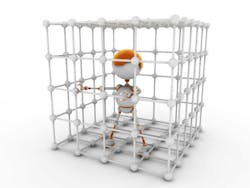“I am sorry Tom but "Really? That's how MH&L wants to talk about a “man-basket" or "man-cage?" You have to get the forklift's manufacturer to change their data plate to accommodate it? While far too many warehouses are lifting their people on open forks or open pallets, with NO protection, you are focused on a bureaucratic extra step that will NOT save a life.
“This is an 800 lb. load at 24 inch load center. What are they going to change?
“The example you showed of a forklift tipping because it turned quickly with its forks at full height probably would have happened without a man-basket on the forks. It definitely would have happened with a skid of product on its forks. I am sorry but that is a ridiculous example of 'why changing a data plate is important.'
“To focus on changing the data plate for a man-basket discourages companies from even using this safety device. That is a good example where bureaucracy misses the mark, and I would argue, even discourages safe practices.”
You would think a manufacturer of such devices would agree with this trainer, but as we reported, Matt Clemens, director of engineering for Vestil, told us that failing to contact the OEM is one of the most common mistakes users make. He added that some will even buy one of these platforms and use it on 17 different trucks in their facility. We stated that according to OSHA requirements they’d need a data plate for each of those forklifts. Silly?
If Hoover had his way he’d ban these devices completely.
“Lifting people with forklifts has been a bad idea since they day forklifts were invented,” he said—speaking of general industry sit down riders, not trucks like order pickers designed for man-up use.
Hoover acknowledges that these “cages” are safer than letting people stand on a pallet or on the forks, but we shouldn’t be giving in to necessary evils in the first place.
“If neither is safe, then neither should be used,” he says. “Picking the better of two bad options makes no safety sense. Any company that can't control this type of activity has management issues and does not have proper control over their facility and people. Saying the man cages are better than other methods of lifting people is about like saying smoking crack is better than shooting heroin.”
“We can talk about all the ANSI required man cage rules in great detail, they are excellent,” Hoover continues. “That could be another entire article but it would be an article only for people who had done their due diligence and received proper permission to use them, which will be VERY few people; all the rest are in violation of federal OSHA standards. We don’t want people to stop using them and go back to the old ways, we want them to use newer and safer ways like aerial lifts.”
“Let’s be clear, OSHA is not concerned about whether most forklifts can lift a man cage capacity wise, however it does change safe operation of the truck and is an attachment—and for that you must have permission from the people who made the truck. We know, however that permission can be hard to obtain and that many manufacturers won’t give it, because it opens them up to liability, since when an accident happens EVERYONE with money gets sued.”
So where does that leave you? Hoover says if you’re using a man cage you should get rid of it and invest in an aerial work platform. You say you can’t afford one? Then you definitely can’t afford what a man cage will cost if someone gets hurt in one and a lawyer comes after you for damages.
To me, this process of contacting the OEM or material handling equipment dealer serves a purpose separate from getting permission to use the attachment. As a result of that outreach the provider might actually give you some good advice for using their product safer. The data plate is the kind of thing film-maker Alfred Hitchcock referred to as a MacGuffin—an object in a murder mystery that sets off the movie’s whole chain of events. Despite all the attention it gets, the movie is about something else entirely. In the case of man cages, safety should be the star.
(Click HERE to see examples of "man cages" used properly as well as stupidly.)
About the Author
Tom Andel Blog
former Editor-in-Chief
As editor-in-chief from 2010-2014, Tom Andel oversaw the strategic development of MH&L and MHLnews.com, bringing 30+ years of thought leadership and award winning coverage of supply chain, manufacturing logistics and material handling. Throughout his career he also served in various editorial capacities at other industry titles, including Transportation & Distribution, Material Handling Engineering, Material Handling Management (predecessors to MH&L), as well as Logistics Management and Modern Materials Handling. Andel is a three-time finalist in the Jesse H. Neal Business Journalism Awards, the most respected editorial award in B2B trade publishing, and a graduate of Cleveland’s Case Western Reserve University.

